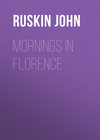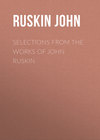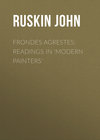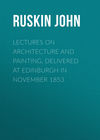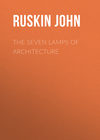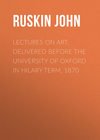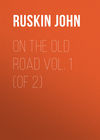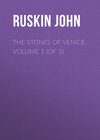Loe raamatut: «Mornings in Florence», lehekülg 6
Accordingly, I have myself taken five weeks to see the quarter of this picture of Simon Memmi's: and can give you a fairly good account of that quarter, and some partial account of a fragment or two of those on the other walls: but, alas! only of their pictorial qualities in either case; for I don't myself know anything whatever, worth trusting to, about Pythagoras, or Dionysius the Areopagite; and have not had, and never shall have, probably, any time to learn much of them; while in the very feeblest light only,—in what the French would express by their excellent word 'lueur,'—I am able to understand something of the characters of Zoroaster, Aristotle, and Justinian. But this only increases in me the reverence with which I ought to stand before the work of a painter, who was not only a master of his own craft, but so profound a scholar and theologian as to be able to conceive this scheme of picture, and write the divine law by which Florence was to live. Which Law, written in the northern page of this Vaulted Book, we will begin quiet interpretation of, if you care to return hither, to-morrow morning.
THE FIFTH MORNING
THE STRAIT GATE
As you return this morning to St. Mary's, you may as well observe—the matter before us being concerning gates,—that the western façade of the church is of two periods. Your Murray refers it all to the latest of these;—I forget when, and do not care;—in which the largest flanking columns, and the entire effective mass of the walls, with their riband mosaics and high pediment, were built in front of, and above, what the barbarian renaissance designer chose to leave of the pure old Dominican church. You may see his ungainly jointings at the pedestals of the great columns, running through the pretty, parti-coloured base, which, with the 'Strait' Gothic doors, and the entire lines of the fronting and flanking tombs (where not restored by the Devil-begotten brood of modern Florence), is of pure, and exquisitely severe and refined, fourteenth century Gothic, with superbly carved bearings on its shields. The small detached line of tombs on the left, untouched in its sweet colour and living weed ornament, I would fain have painted, stone by stone: but one can never draw in front of a church in these republican days; for all the blackguard children of the neighbourhood come to howl, and throw stones, on the steps, and the ball or stone play against these sculptured tombs, as a dead wall adapted for that purpose only, is incessant in the fine days when I could have worked.
If you enter by the door most to the left, or north, and turn immediately to the right, on the interior of the wall of the façade is an Annunciation, visible enough because well preserved, though in the dark, and extremely pretty in its way,—of the decorated and ornamental school following Giotto:—I can't guess by whom, nor does it much matter; but it is well To look at it by way of contrast with the delicate, intense, slightly decorated design of Memmi,—in which, when you return into the Spanish chapel, you will feel the dependence for its effect on broad masses of white and pale amber, where the decorative school would have had mosaic of red, blue, and gold.
Our first business this morning must be to read and understand the writing on the book held open by St. Thomas Aquinas, for that informs us of the meaning of the whole picture.
It is this text from the Book of Wisdom VII. 6.
"Optavi, et datus est mihi sensus.
Invocavi, et venit in me Spiritus Sapientiae,
Et preposui illam regnis et sedibus."
"I willed, and Sense was given me.
I prayed, and the Spirit of Wisdom came upon me.
And I set her before, (preferred her to,) kingdoms
and thrones."
The common translation in our English Apocrypha loses the entire meaning of this passage, which—not only as the statement of the experience of Florence in her own education, but as universally descriptive of the process of all noble education whatever—we had better take pains to understand.
First, says Florence "I willed, (in sense of resolutely desiring,) and Sense was given me." You must begin your education with the distinct resolution to know what is true, and choice of the strait and rough road to such knowledge. This choice is offered to every youth and maid at some moment of their life;—choice between the easy downward road, so broad that we can dance down it in companies, and the steep narrow way, which we must enter alone. Then, and for many a day afterwards, they need that form of persistent Option, and Will: but day by day, the 'Sense' of the rightness of what they have done, deepens on them, not in consequence of the effort, but by gift granted in reward of it. And the Sense of difference between right and wrong, and between beautiful and unbeautiful things, is confirmed in the heroic, and fulfilled in the industrious, soul.
That is the process of education in the earthly sciences, and the morality connected with them. Reward given to faithful Volition.
Next, when Moral and Physical senses are perfect, comes the desire for education in the higher world, where the senses are no more our Teachers; but the Maker of the senses. And that teaching, we cannot get by labour, but only by petition.
"Invocavi, et venit in me Spiritus Sapientiae"—"I prayed, and the Spirit of Wisdom," (not, you observe, was given,22 but,) "came upon me." The personal power of Wisdom: the "[Greek: sophia]" or Santa Sophia, to whom the first great Christian temple was dedicated. This higher wisdom, governing by her presence, all earthly conduct, and by her teaching, all earthly art, Florence tells you, she obtained only by prayer.
And these two Earthly and Divine sciences are expressed beneath in the symbols of their divided powers;—Seven terrestrial, Seven celestial, whose names have been already indicated to you:—in which figures I must point out one or two technical matters, before touching their interpretation. They are all by Simon Memmi originally; but repainted, many of them all over, some hundred years later,—(certainly after the discovery of America, as you will see)—by an artist of considerable power, and some feeling for the general action of the figures; but of no refinement or carelessness. He dashes massive paint in huge spaces over the subtle old work, puts in his own chiaro-oscuro where all had been shadeless, and his own violent colour where all had been pale, and repaints the faces so as to make them, to his notion, prettier and more human: some of this upper work has, however, come away since, and the original outline, at least, is traceable; while in the face of the Logic, the Music, and one or two others, the original work is very pure. Being most interested myself in the earthly sciences, I had a scaffolding put up, made on a level with them, and examined them inch by inch, and the following report will be found accurate until next repainting.
For interpretation of them, you must always take the central figure of the Science, with the little medallion above it, and the figure below, all together. Which I proceed to do, reading first from left to right for the earthly sciences, and then from right to left the heavenly ones, to the centre, where their two highest powers sit, side by side.
We begin, then, with the first in the list given above, (Vaulted Book, page 75):—Grammar, in the corner farthest from the window.
1. GRAMMAR: more properly Grammaticë, "Grammatic Act" the Art of Letters or "Literature," or using the word which to some English ears will carry most weight with it,—"Scripture," and its use. The Art of faithfully reading what has been written for our learning; and of clearly writing what we would make immortal of our thoughts. Power which consists first in recognizing letters; secondly, in forming them; thirdly, in the understanding and choice of words which errorless shall express our thought. Severe exercises all, reaching—very few living persons know, how far: beginning properly in childhood, then only to be truly acquired. It is wholly impossible—this I say from too sorrowful experience—to conquer by any effort or time, habits of the hand (much more of head and soul) with which the vase of flesh has been formed and filled in youth,—the law of God being that parents shall compel the child in the day of its obedience into habits of hand, and eye, and soul, which, when it is old, shall not, by any strength, or any weakness, be departed from.
"Enter ye in," therefore, says Grammaticë, "at the Strait Gate." She points through it with her rod, holding a fruit(?) for reward, in her left hand. The gate is very strait indeed—her own waist no less so, her hair fastened close. She had once a white veil binding it, which is lost. Not a gushing form of literature, this,—or in any wise disposed to subscribe to Mudie's, my English friends—or even patronize Tauchnitz editions of—what is the last new novel you see ticketed up today in Mr. Goodban's window? She looks kindly down, nevertheless, to the three children whom she is teaching—two boys and a girl: (Qy. Does this mean that one girl out of every two should not be able to read or write? I am quite willing to accept that inference, for my own part,—should perhaps even say, two girls out of three). This girl is of the highest classes, crowned, her golden hair falling behind her the Florentine girdle round her hips—(not waist, the object being to leave the lungs full play; but to keep the dress always well down in dancing or running). The boys are of good birth also, the nearest one with luxuriant curly hair—only the profile of the farther one seen. All reverent and eager. Above, the medallion is of a figure looking at a fountain. Underneath, Lord Lindsay says, Priscian, and is, I doubt not, right.
Technical Points.—The figure is said by Crowe to be entirely repainted. The dress is so throughout—both the hands also, and the fruit, and rod. But the eyes, mouth, hair above the forehead, and outline of the rest, with the faded veil, and happily, the traces left of the children, are genuine; the strait gate perfectly so, in the colour underneath, though reinforced; and the action of the entire figure is well preserved: but there is a curious question about both the rod and fruit. Seen close, the former perfectly assumes the shape of folds of dress gathered up over the raised right arm, and I am not absolutely sure that the restorer has not mistaken the folds—at the same time changing a pen or style into a rod. The fruit also I have doubts of, as fruit is not so rare at Florence that it should be made a reward. It is entirely and roughly repainted, and is oval in shape. In Giotto's Charity, luckily not restored, at Assisi, the guide-books have always mistaken the heart she holds for an apple:—and my own belief is that originally, the Grammaticë of Simon Memmi made with her right hand the sign which said, "Enter ye in at the Strait Gate," and with her left, the sign which said, "My son, give me thine Heart."
II. RHETORIC. Next to learning how to read and write, you are to learn to speak; and, young ladies and gentlemen, observe,—to speak as little as possible, it is farther implied, till you have learned.
In the streets of Florence at this day you may hear much of what some people call "rhetoric"—very passionate speaking indeed, and quite "from the heart"—such hearts as the people have got. That is to say, you never hear a word uttered but in a rage, either just ready to burst, or for the most part, explosive instantly: everybody—man, woman, or child—roaring out their incontinent, foolish, infinitely contemptible opinions and wills, on every smallest occasion, with flashing eyes, hoarsely shrieking and wasted voices,—insane hope to drag by vociferation whatever they would have, out of man and God.
Now consider Simon Memmi's Rhetoric. The Science of Speaking, primarily; of making oneself heard therefore: which is not to be done by shouting. She alone, of all the sciences, carries a scroll: and being a speaker gives you something to read. It is not thrust forward at you at all, but held quietly down with her beautiful depressed right hand; her left hand set coolly and strongly on her side.
And you will find that, thus, she alone of all the sciences needs no use of her hands. All the others have some important business for them. She none. She can do all with her lips, holding scroll, or bridle, or what you will, with her right hand, her left on her side.
Again, look at the talkers in the streets of Florence, and see how, being essentially unable to talk, they try to make lips of their fingers! How they poke, wave, flourish, point, jerk, shake finger and fist at their antagonists—dumb essentially, all the while, if they knew it; unpersuasive and ineffectual, as the shaking of tree branches in the wind.
You will at first think her figure ungainly and stiff. It is so, partly, the dress being more coarsely repainted than in any other of the series. But she is meant to be both stout and strong. What she has to say is indeed to persuade you, if possible; but assuredly to overpower you. And she has not the Florentine girdle, for she does not want to move. She has her girdle broad at the waist—of all the sciences, you would at first have thought, the one that most needed breath! No, says Simon Memmi. You want breath to run, or dance, or fight with. But to speak!—If you know how, you can do your work with few words; very little of this pure Florentine air will be enough, if you shape it rightly.
Note, also, that calm setting of her hand against her side. You think Rhetoric should be glowing, fervid, impetuous? No, says Simon Memmi. Above all things,—cool.
And now let us read what is written on her scroll:—Mulceo, dum loquor, varios induta colores.
Her chief function, to melt; make soft, thaw the hearts of men with kind fire; to overpower with peace; and bring rest, with rainbow colours. The chief mission of all words that they should be of comfort.
You think the function of words is to excite? Why, a red rag will do that, or a blast through a brass pipe. But to give calm and gentle heat; to be as the south wind, and the iridescent rain, to all bitterness of frost; and bring at once strength, and healing. This is the work of human lips, taught of God.
One farther and final lesson is given in the medallion above. Aristotle, and too many modern rhetoricians of his school, thought there could be good speaking in a false cause. But above Simon Memmi's Rhetoric is Truth, with her mirror.
There is a curious feeling, almost innate in men, that though they are bound to speak truth, in speaking to a single person, they may lie as much as they please, provided they lie to two or more people at once. There is the same feeling about killing: most people would shrink from shooting one innocent man; but will fire a mitrailleuse contentedly into an innocent regiment.
When you look down from the figure of the Science, to that of Cicero, beneath, you will at first think it entirely overthrows my conclusion that Rhetoric has no need of her hands. For Cicero, it appears, has three instead of two.
The uppermost, at his chin, is the only genuine one. That raised, with the finger up, is entirely false. That on the book, is repainted so as to defy conjecture of its original action.
But observe how the gesture of the true one confirms instead of overthrowing what I have said above. Cicero is not speaking at all, but profoundly thinking before he speaks. It is the most abstractedly thoughtful face to be found among all the philosophers; and very beautiful. The whole is under Solomon, in the line of Prophets.
Technical Points.—These two figures have suffered from restoration more than any others, but the right hand of Rhetoric is still entirely genuine, and the left, except the ends of the fingers. The ear, and hair just above it, are quite safe, the head well set on its original line, but the crown of leaves rudely retouched, and then faded. All the lower part of the figure of Cicero has been not only repainted but changed; the face is genuine—I believe retouched, but so cautiously and skilfully, that it is probably now more beautiful than at first.
III. LOGIC. The science of reasoning, or more accurately Reason herself, or pure intelligence.
Science to be gained after that of Expression, says Simon Memmi; so, young people, it appears, that though you must not speak before you have been taught how to speak, you may yet properly speak before you have been taught how to think.
For indeed, it is only by frank speaking that you can learn how to think. And it is no matter how wrong the first thoughts you have may be, provided you express them clearly;—and are willing to have them put right.
Fortunately, nearly all of this beautiful figure is practically safe, the outlines pure everywhere, and the face perfect: the prettiest, as far as I know, which exists in Italian art of this early date. It is subtle to the extreme in gradations of colour: the eyebrows drawn, not with a sweep of the brush, but with separate cross touches in the line of their growth—exquisitely pure in arch; the nose straight and fine; the lips—playful slightly, proud, unerringly cut; the hair flowing in sequent waves, ordered as if in musical time; head perfectly upright on the shoulders; the height of the brow completed by a crimson frontlet set with pearls, surmounted by a fleur-de-lys.
Her shoulders were exquisitely drawn, her white jacket fitting close to soft, yet scarcely rising breasts; her arms singularly strong, at perfect rest; her hands, exquisitely delicate. In her right, she holds a branching and leaf-bearing rod, (the syllogism); in her left, a scorpion with double sting, (the dilemma)—more generally, the powers of rational construction and dissolution.
Beneath her, Aristotle,—intense keenness of search in his half-closed eyes.
Medallion above, (less expressive than usual) a man writing, with his head stooped.
The whole under Isaiah, in the line of Prophets.
Technical Points.—The only parts of this figure which have suffered seriously in repainting are the leaves of the rod, and the scorpion. I have no idea, as I said above, what the background once was; it is now a mere mess of scrabbled grey, carried over the vestiges, still with care much redeemable, of the richly ornamental extremity of the rod, which was a cluster of green leaves on a black ground. But the scorpion is indecipherably injured, most of it confused repainting, mixed with the white of the dress, the double sting emphatic enough still, but not on the first lines.
The Aristotle is very genuine throughout, except his hat, and I think that must be pretty nearly on the old lines, through I cannot trace them. They are good lines, new or old.
IV. MUSIC. After you have learned to reason, young people, of course you will be very grave, if not dull, you think. No, says Simon Memmi. By no means anything of the kind. After learning to reason, you will learn to sing; for you will want to. There is so much reason for singing in the sweet world, when one thinks rightly of it. None for grumbling, provided always you have entered in at the strait gate. You will sing all along the road then, in a little while, in a manner pleasant for other people to hear.
This figure has been one of the loveliest in the series, an extreme refinement and tender severity being aimed at throughout. She is crowned, not with laurel, but with small leaves,—I am not sure what they are, being too much injured: the face thin, abstracted, wistful; the lips not far open in their low singing; the hair rippling softly on the shoulders. She plays on a small organ, richly ornamented with Gothic tracery, the down slope of it set with crockets like those of Santa Maria del Fiore. Simon Memmi means that all music must be "sacred." Not that you are never to sing anything but hymns, but that whatever is rightly called music, or work of the Muses, is divine in help and healing.
The actions of both hands are singularly sweet. The right is one of the loveliest things I ever saw done in painting. She is keeping down one note only, with her third finger, seen under the raised fourth: the thumb, just passing under; all the curves of the fingers exquisite, and the pale light and shade of the rosy flesh relieved against the ivory white and brown of the notes. Only the thumb and end of the forefinger are seen of the left hand, but they indicate enough its light pressure on the bellows. Fortunately, all these portions of the fresco are absolutely intact.
Underneath, Tubal-Cain. Not Jubal, as you would expect. Jubal is the inventor of musical instruments. Tubal-Cain, thought the old Florentines, invented harmony. They, the best smiths in the world, knew the differences in tones of hammer strokes on anvil. Curiously enough, the only piece of true part-singing, done beautifully and joyfully, which I have heard this year in Italy, (being south of Alps exactly six months, and ranging from Genoa to Palermo) was out of a busy smithy at Perugia. Of bestial howling, and entirely frantic vomiting up of hopelessly damned souls through their still carnal throats, I have heard more than, please God, I will ever endure the hearing of again in one of His summers.
You think Tubal-Cain very ugly? Yes. Much like a shaggy baboon: not accidentally, but with most scientific understanding of baboon character. Men must have looked like that, before they had invented harmony, or felt that one note differed from another, says, and knows Simon Memmi. Darwinism, like all widely popular and widely mischievous fallacies, has many a curious gleam and grain of truth in its tissue.
Under Moses.
Medallion, a youth drinking. Otherwise, you might have thought only church music meant, and not feast music also.
Technical Points.—The Tubal-Cain, one of the most entirely pure and precious remnants of the old painting, nothing lost: nothing but the redder ends of his beard retouched. Green dress of Music, in the body and over limbs entirely repainted: it was once beautifully embroidered; sleeves, partly genuine, hands perfect, face and hair nearly so. Leaf crown faded and broken away, but not retouched.
V. ASTRONOMY. Properly Astro-logy, as (Theology) the knowledge of so much of the stars as we can know wisely; not the attempt to define their laws for them. Not that it is unbecoming of us to find out, if we can, that they move in ellipses, and so on; but it is no business of ours. What effects their rising and setting have on man, and beast, and leaf; what their times and changes are, seen and felt in this world, it is our business to know, passing our nights, if wakefully, by that divine candlelight, and no other.
She wears a dark purple robe; holds in her left hand the hollow globe with golden zodiac and meridians: lifts her right hand in noble awe.
"When I consider the heavens, the work of Thy fingers, the moon and the stars, which Thou hast ordained."
Crowned with gold, her dark hair in elliptic waves, bound with glittering chains of pearl. Her eyes dark, lifted.
Beneath her, Zoroaster,23 entirely noble and beautiful, the delicate Persian head made softer still by the elaborately wreathed silken hair, twisted into the pointed beard, and into tapering plaits, falling on his shoulders. The head entirely thrown back, he looks up with no distortion of the delicately arched brow: writing, as he gazes.
For the association of the religion of the Magi with their own in the mind of the Florentines of this time, see "Before the Soldan."
The dress must always have been white, because of its beautiful opposition to the purple above and that of Tubal-Cain beside it. But it has been too much repainted to be trusted anywhere, nothing left but a fold or two in the sleeves. The cast of it from the knees down is entirely beautiful, and I suppose on the old lines; but the restorer could throw a fold well when he chose. The warm light which relieves the purple of Zoroaster above, is laid in by him. I don't know if I should have liked it better, flat, as it was, against the dark purple; it seems to me quite beautiful now. The full red flush on the face of the Astronomy is the restorer's doing also. She was much paler, if not quite pale.
Under St. Luke.
Medallion, a stern man, with sickle and spade. For the flowers, and for us, when stars have risen and set such and such times;—remember.
Technical Points.—Left hand globe, most of the important folds of the purple dress, eyes, mouth, hair in great part, and crown, genuine. Golden tracery on border of dress lost; extremity of falling folds from left sleeve altered and confused, but the confusion prettily got out of. Right hand and much of face and body of dress repainted.
Zoroaster's head quite pure. Dress repainted, but carefully, leaving the hair untouched. Right hand and pen, now a common feathered quill, entirely repainted, but dexterously and with feeling. The hand was once slightly different in position, and held, most probably, a reed.
VI. GEOMETRY. You have now learned, young ladies and gentlemen, to read, to speak, to think, to sing, and to see. You are getting old, and will have soon to think of being married; you must learn to build your house, therefore. Here is your carpenter's square for you, and you may safely and wisely contemplate the ground a little, and the measures and laws relating to that, seeing you have got to abide upon it:—and that you have properly looked at the stars; not before then, lest, had you studied the ground first, you might perchance never have raised your heads from it. This is properly the science of all laws of practical labour, issuing in beauty.
She looks down, a little puzzled, greatly interested, holding her carpenter's square in her left hand, not wanting that but for practical work; following a diagram with her right.
Her beauty, altogether soft and in curves, I commend to your notice, as the exact opposite of what a vulgar designer would have imagined for her. Note the wreath of hair at the back of her head, which though fastened by a spiral fillet, escapes at last, and flies off loose in a sweeping curve. Contemplative Theology is the only other of the sciences who has such wavy hair.
Beneath her, Euclid, in white turban. Very fine and original work throughout; but nothing of special interest in him.
Under St. Matthew.
Medallion, a soldier with a straight sword (best for science of defence), octagon shield, helmet like the beehive of Canton Vaud. As the secondary use of music in feasting, so the secondary use of geometry in war—her noble art being all in sweetest peace—is shown in the medallion.
Technical Points.—It is more than fortunate that in nearly every figure, the original outline of the hair is safe. Geometry's has scarcely been retouched at all, except at the ends, once in single knots, now in confused double ones. The hands, girdle, most of her dress, and her black carpenter's square are original. Face and breast repainted.
VII. ARITHMETIC. Having built your house, young people, and understanding the light of heaven, and the measures of earth, you may marry—and can't do better. And here is now your conclusive science, which you will have to apply, all your days, to all your affairs.
The Science of Number. Infinite in solemnity of use in Italy at this time; including, of course, whatever was known of the higher abstract mathematics and mysteries of numbers, but reverenced especially in its vital necessity to the prosperity of families and kingdoms, and first fully so understood here in commercial Florence.
Her hand lifted, with two fingers bent, two straight, solemnly enforcing on your attention her primal law—Two and two are—four, you observe,—not five, as those accursed usurers think.
Under her, Pythagoras.
Above, medallion of king, with sceptre and globe, counting money. Have you ever chanced to read carefully Carlyle's account of the foundation of the existing Prussian empire, in economy?
You can, at all events, consider with yourself a little, what empire this queen of the terrestrial sciences must hold over the rest, if they are to be put to good use; or what depth and breadth of application there is in the brief parables of the counted cost of Power, and number of Armies.
To give a very minor, but characteristic, instance. I have always felt that with my intense love of the Alps, I ought to have been able to make a drawing of Chamouni, or the vale of Cluse, which should give people more pleasure than a photograph; but I always wanted to do it as I saw it, and engrave pine for pine, and crag for crag, like Albert Dürer. I broke my strength down for many a year, always tiring of my work, or finding the leaves drop off, or the snow come on, before I had well begun what I meant to do. If I had only counted my pines first, and calculated the number of hours necessary to do them in the manner of Dürer, I should have saved the available drawing time of some five years, spent in vain effort.
But Turner counted his pines, and did all that could be done for them, and rested content with that.
So in all the affairs of life, the arithmetical part of the business is the dominant one. How many and how much have we? How many and how much do we want? How constantly does noble Arithmetic of the finite lose itself in base Avarice of the Infinite, and in blind imagination of it! In counting of minutes, is our arithmetic ever solicitous enough? In counting our days, is she ever severe enough? How we shrink from putting, in their decades, the diminished store of them! And if we ever pray the solemn prayer that we may be taught to number them, do we even try to do it after praying?
Technical Points.—The Pythagoras almost entirely genuine. The upper figures, from this inclusive to the outer wall, I have not been able to examine thoroughly, my scaffolding not extending beyond the Geometry.
Here then we have the sum of sciences,—seven, according to the Florentine mind—necessary to the secular education of man and woman. Of these the modern average respectable English gentleman and gentlewoman know usually only a little of the last, and entirely hate the prudent applications of that: being unacquainted, except as they chance here and there to pick up a broken piece of information, with either grammar, rhetoric, music,24 astronomy, or geometry; and are not only unacquainted with logic, or the use of reason, themselves, but instinctively antagonistic to its use by anybody else.
